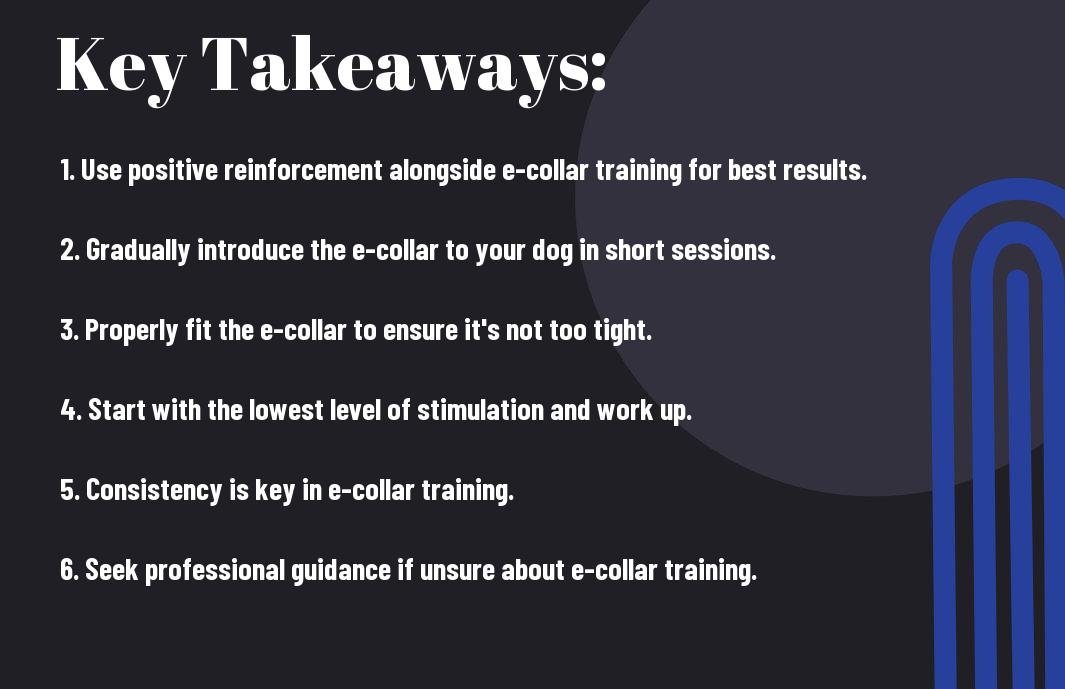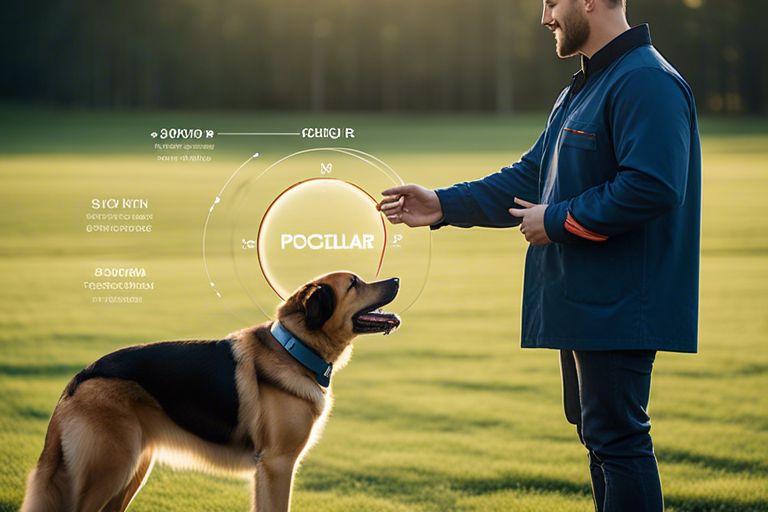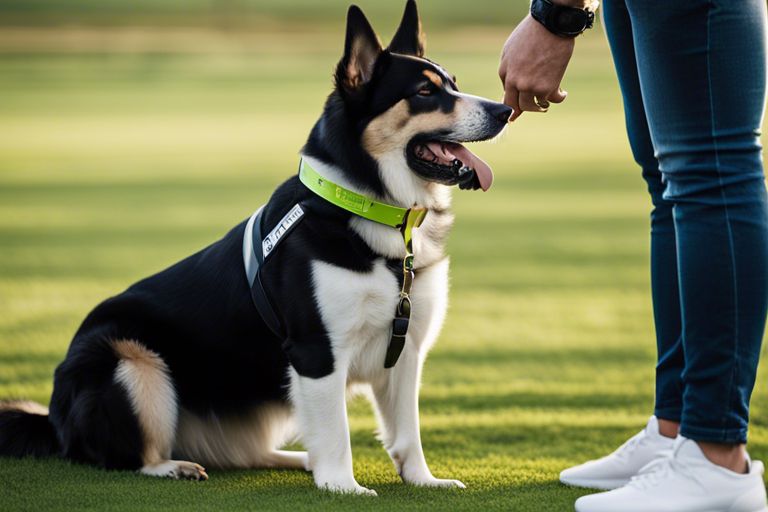Are you struggling to effectively train your canine companions? Look no further than the e collar. These devices, also referred to as electronic collars or remote training collars, are a revolutionary tool for communicating with and training multiple dogs simultaneously. By using carefully calibrated stimulation levels, you can address a wide range of behavioral issues, from excessive barking to aggression, without physically restraining or harming your pets.
It’s important to note that e collars can be dangerous in the wrong hands, and there are misconceptions and myths surrounding their use. However, when used properly, they can be an incredibly effective and humane tool for training your furry friends. In this blog post, we’ll discuss the key principles and techniques for using e collars to train your dogs effectively and responsibly.
Key Takeaways:
- Proper Fit – Ensure the e-collar is fitted correctly on your dog to avoid discomfort or injury.
- Positive Reinforcement – Use the e-collar in conjunction with positive reinforcement techniques to encourage good behavior.
- Consistent Training – Be consistent with the e-collar training to reinforce desired behaviors and discourage negative ones.
- Gradual Introduction – Introduce the e-collar gradually to your dog, starting with low levels of stimulation and increasing as they become familiar with it.
- Professional Guidance – Seek the advice of a professional dog trainer to ensure proper use of the e-collar and to address any concerns or issues.

Preparing for E-Collar Training
If you are considering using an e-collar to train your dogs, it’s essential to properly prepare for the process. This includes selecting the right e-collar, familiarizing your dogs with the collar, and establishing a baseline for stimulation. By taking these steps, you can ensure that the e-collar training process is safe, effective, and ultimately successful.
Selecting the Right E-Collars
An e-collar is a tool that allows you to remotely deliver electrical stimulation, vibration, or sound to your dogs in order to reinforce commands or correct undesirable behaviors. When selecting an e-collar, it’s important to choose a model that is appropriate for your dogs’ size, temperament, and training needs. Look for e-collars that offer a range of stimulation levels, as well as features such as waterproofing and long battery life to ensure durability and reliability.
Familiarizing Your Dogs with the E-Collars
For the best results, take the time to familiarize your dogs with the e-collar before using it for training. Allow them to become comfortable wearing the collar by providing positive associations, such as offering treats while they wear it. It’s important for your dogs to have a positive association with the e-collar to prevent any potential aversion or fear.
A gradual approach to introducing the e-collar to your dogs can help to minimize any stress or anxiety they may experience. Start by simply having them wear the collar without any stimulation, allowing them to adjust to the sensation of wearing it. Gradually introduce the concept of stimulation with low levels, and always monitor their reactions to ensure they are comfortable with the device.
It’s important to approach familiarizing your dogs with the e-collar with patience and positive reinforcement. Rushing the process or using negative associations can result in resistance or fear of the device.
Establishing a Baseline for Stimulation
Training your dogs with an e-collar requires establishing a baseline for stimulation, which means determining the appropriate level of stimulation for each command or correction. Start by identifying the lowest level of stimulation that your dogs respond to, and use this as a baseline for future training. This can help to ensure that the e-collar is used as a gentle, effective tool, rather than a harsh or punitive one.
Right from the start, it’s crucial to use the e-collar as a supplement to positive reinforcement training, rather than a replacement for it. This means that the e-collar should be used in conjunction with verbal commands and rewards, and never as a standalone tool for training.
Establishing a baseline for stimulation is crucial for ensuring that the e-collar is used safely and effectively. It’s also important to use the e-collar as a complement to positive reinforcement training, rather than a substitute for it.
Basic Training with an E-Collar
Not all dog owners are familiar with the proper use of an e-collar in training, but when used correctly, it can be a powerful tool for shaping behavior and reinforcing commands.
Incorporating the E-Collar into Basic Commands
For those who are new to e-collar training, it is important to first introduce the device to your dogs and let them become comfortable with wearing it. Once they are accustomed to the collar, you can begin incorporating it into basic commands such as sit, stay, and come. It is crucial to start with low levels of stimulation and gradually increase as needed, always observing your dogs’ body language and behavior for any signs of distress.
Timing and Consistency in E-Collar Use
On the topic of timing and consistency, it is important to remember that the e-collar is meant to be a supplement to your verbal commands, not a replacement. When giving a command, use the e-collar immediately to reinforce the behavior, creating a strong association between the command and the stimulation. Consistency is key in e-collar training, as mixed signals can confuse your dogs and hinder their progress.
Commands should always be clear and concise, and the timing of the stimulation should correspond directly to the desired behavior. It is important to maintain consistency in the levels of stimulation used for each command, as well as being mindful of the specific situations in which the e-collar is used.
Reward-Based Reinforcement
Consistency in using rewards alongside the e-collar is vital in ensuring that your dogs understand the desired behavior. Consistently rewarding them with praise, treats, or playtime after a successful response to the e-collar stimulation will motivate them to continue obeying commands.
Timing is key in reward-based reinforcement, as the reward must be given immediately following the desired behavior to reinforce the connection between the command, the e-collar stimulation, and the positive outcome.
Advanced E-Collar Training Techniques
Now that you have mastered the basics of e-collar training for your dogs, it’s time to delve into some advanced techniques that will take your training to the next level. These techniques will help you work with distractions, increase distance control, and even train your dogs to be off-leash with the e-collar.
- Working with Distractions
- Increasing Distance Control
- Off-Leash Training with an E-Collar
Working with Distractions
With advanced e-collar training, it’s crucial to work with distractions to ensure that your dogs respond to commands even in challenging environments. Start by introducing controlled distractions, such as toys or food, and gradually increase the level of distraction. Use the e-collar to reinforce commands and ensure that your dogs stay focused on you despite the distractions.
Increasing Distance Control
On top of working with distractions, increasing distance control is another key aspect of advanced e-collar training. Use the e-collar to communicate with your dogs from a distance and reinforce commands even when they are far away from you. Start with short distances and gradually increase the gap, making sure your dogs respond to your commands reliably no matter how far they are from you.
With increasing distance control, you will have the ability to call your dogs back to you or give them commands from a distance, making the e-collar an invaluable tool for off-leash training.
Off-Leash Training with an E-Collar
Training your dogs to be off-leash with an e-collar provides them with freedom while still maintaining control and ensuring their safety. This involves teaching them to respond to commands without the constraint of a leash, relying on the e-collar to reinforce your instructions consistently.
Plus, off-leash training with an e-collar opens up opportunities for your dogs to explore and enjoy an active lifestyle with you while staying under your guidance and supervision.

E-Collar Training for Specific Behaviors
For those looking to address specific behaviors in their dogs, e-collar training can be an effective tool. If you’re new to e-collar training, it’s important to start with the basics. You can learn more about how to introduce e-collar training here.
Addressing Aggression and Barking
The e-collar can be a powerful tool for addressing aggression and excessive barking in dogs. Aggressive behavior and incessant barking can be dangerous for both your dog and others, so it’s important to address these behaviors effectively. The e-collar can help discourage these behaviors by providing a quick and consistent correction when they occur.
E-Collar Recall: Teaching Your Dogs to Come
The e-collar can be used to train your dogs to come when called, regardless of distractions. The ability to recall your dogs is crucial for their safety, especially in potentially dangerous situations. The e-collar can provide a reliable and consistent way to reinforce the recall command, ensuring that your dogs come back to you every time.
Come command is essential for off-leash walks and can help prevent your dogs from running into traffic or getting lost.
E-Collar Boundary Training for Property Lines
Your dogs need to understand where the boundaries of your property lie, and the e-collar can help enforce these boundaries effectively. Keeping your dogs within your property lines can prevent them from getting lost or running into dangerous situations. The e-collar can provide a clear and consistent signal that your dogs have reached the boundary, reinforcing their understanding of where they should stay.
This training can also prevent your dogs from bothering neighbors or wandering into areas where they’re not welcome.
Troubleshooting Common E-Collar Training Issues
Keep in mind that some dogs may take longer to adjust to e-collar training than others. If you’re experiencing challenges, it’s important to seek advice from experienced trainers. You can find valuable insights and tips on how to get started with an e-collar for off-leash training in the advice on how to get started with an e-collar for off leash … thread on Reddit.
Overcoming Resistance to E-Collar Training
To overcome resistance to e-collar training, it’s crucial to ensure that the e-collar is properly fitted and that your dog is comfortable wearing it. Additionally, gradually introducing the e-collar in short training sessions can help your dogs acclimate to the device. Start with low levels of stimulation and gradually increase it as your dogs become more familiar with the e-collar.
Adjusting Stimulation Levels Appropriately
The key to adjusting stimulation levels appropriately is to observe your dogs’ reactions closely. The stimulation level should be set at the lowest possible level that gets your dogs’ attention. It’s important to avoid overstimulating your dogs, as this can lead to confusion and anxiety. It’s also essential to periodically re-evaluate the stimulation levels as your dogs’ training progresses and they become more responsive to the e-collar.
It’s crucial to understand that each dog may require a different level of stimulation, and it may vary based on factors such as their temperament and the specific training scenario. A personalized approach to adjusting stimulation levels is essential to achieve positive training outcomes.
Transitioning Away from the E-Collar
Resistance to transitioning away from the e-collar often stems from a lack of consistent training and reinforcement of desired behaviors. It’s important to gradually reduce the reliance on the e-collar as your dogs become more responsive to verbal commands and cues. Consistent training and positive reinforcement are key elements in this process, ensuring that your dogs internalize the expected behaviors and respond reliably without the e-collar.
Training takes time and patience, and the transition away from the e-collar requires a gradual phasing out of its use. It’s important to maintain a consistent and structured training routine to ensure that your dogs retain the learned behaviors and respond appropriately without the e-collar.

Ethical Considerations and Best Practices
Despite the growing popularity of e-collar training for dogs, it is important to consider the ethical implications and best practices associated with this method. While e-collars can be effective tools for training, they must be used responsibly and with the welfare of the dog in mind. Understanding the controversy surrounding e-collar use and prioritizing canine welfare can help guide dog owners in making informed decisions about the use of e-collars in training.
Understanding the Controversy Surrounding E-Collar Use
To fully understand the controversy surrounding the use of e-collars for dog training, it is important to recognize that opinions on their effectiveness and safety vary widely among dog trainers, veterinarians, and animal welfare organizations. While some argue that e-collars can be a valuable tool when used correctly, others express concerns about their potential for physical and psychological harm to dogs. This controversy underscores the need for responsible and informed use of e-collars.
E-Collar Training and Canine Welfare
Controversy surrounding the use of e-collars in dog training highlights the importance of prioritizing canine welfare in any training approach. This means ensuring that the use of e-collars is accompanied by positive reinforcement, proper training techniques, and a thorough understanding of a dog’s individual needs and behaviors. A commitment to canine welfare should guide the use of e-collars to avoid any potential harm or stress to dogs.
This requires a thorough evaluation of a dog’s temperament, responsiveness to training, and overall well-being when considering the use of e-collars. Understanding the potential risks and benefits of e-collar training and making informed decisions based on individual dogs’ needs is crucial in ensuring their welfare.
Maintaining a Positive Relationship with Your Dog
The use of e-collars for dog training should be accompanied by a focus on maintaining a positive and healthy relationship between dogs and their owners. This means employing positive reinforcement, clear communication, and building trust and respect between dogs and their owners. Maintaining a positive relationship with dogs is essential in ensuring their well-being and happiness throughout the training process.
Relationship-building exercises, such as regular playtime, obedience training, and rewards-based training, can help strengthen the bond between dogs and their owners while using e-collars as a training tool.
Conclusion
Conclusively, training a dog with an e-collar can be an effective and humane way to modify their behavior. By ensuring that you are using the e-collar correctly and following proper training techniques, you can help your dog understand what behaviors are acceptable and which ones are not. It is important to remember that the e-collar should only be used as a training tool in conjunction with positive reinforcement and never as a punishment.
Additionally, consulting with a professional dog trainer or behaviorist before using an e-collar can provide valuable guidance and ensure that you are using it in a safe and appropriate manner. With patience, consistency, and proper training, the e-collar can be a useful tool in helping your dog become a well-behaved and well-adjusted member of your family.
FAQ
Q: What is an e-collar for training dogs?
A: An e-collar, or electronic collar, is a tool used in dog training that delivers a mild electric stimulus to the dog’s neck when a remote control button is pressed. It is often used to reinforce commands and to deter undesirable behaviors.
Q: Is it safe to train a dog with an e-collar?
A: When used properly, e-collars are safe and effective tools for training dogs. It is important to follow manufacturer’s instructions and seek guidance from a professional dog trainer to ensure proper usage.
Q: How do I introduce my dog to the e-collar?
A: Begin by allowing your dog to become familiar with the e-collar, wearing it without the stimulation feature activated. Gradually introduce the sensation by pairing it with a known command and positive reinforcement.
Q: What behaviors can be trained using an e-collar?
A: E-collars can be used to train a wide range of behaviors such as obedience commands, recall, and leash manners. They can also be used to deter behaviors like excessive barking or chasing wildlife.
Q: Are there any risks associated with using an e-collar for dog training?
A: While e-collars are generally safe when used correctly, misuse or overuse can lead to behavioral issues or physical harm. It is crucial to educate oneself on proper usage and consider seeking professional guidance before incorporating an e-collar into your dog’s training regimen.
